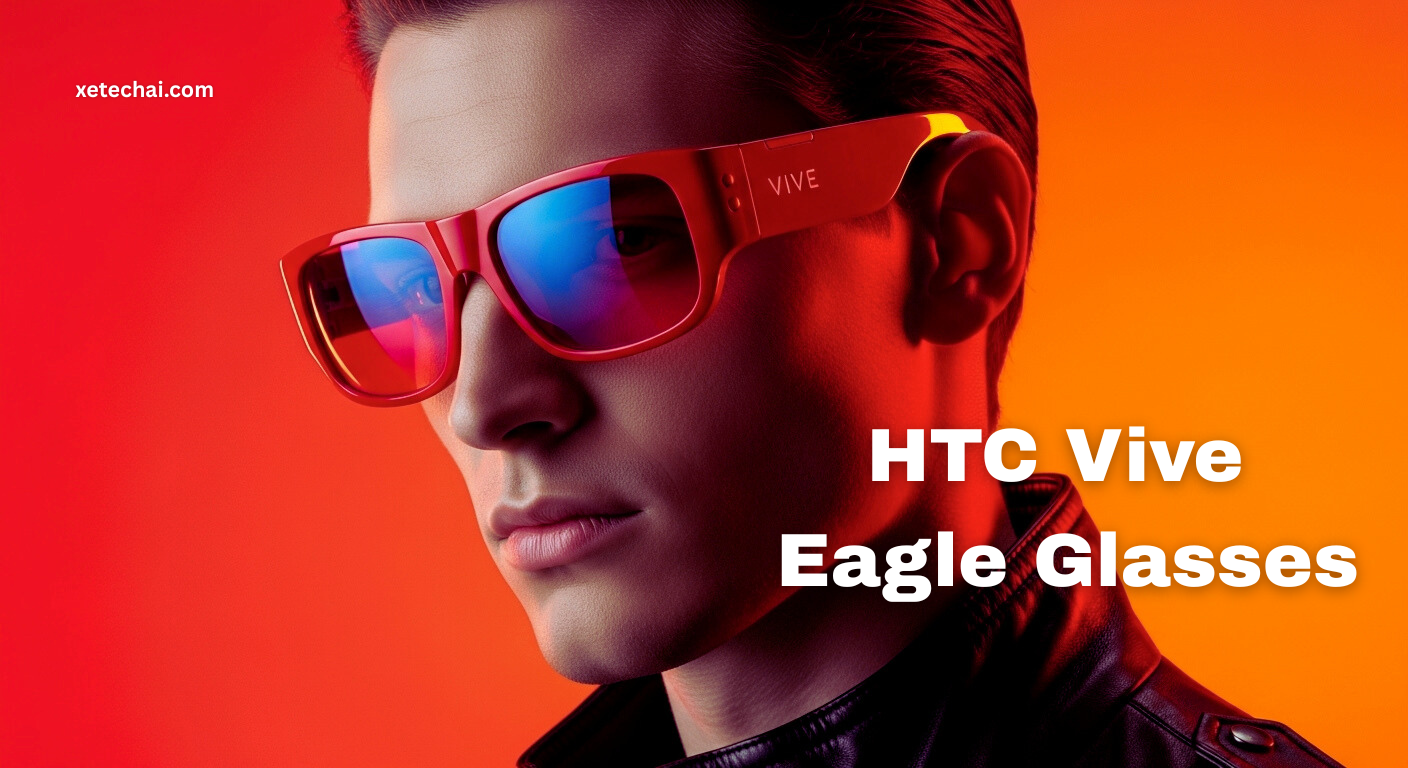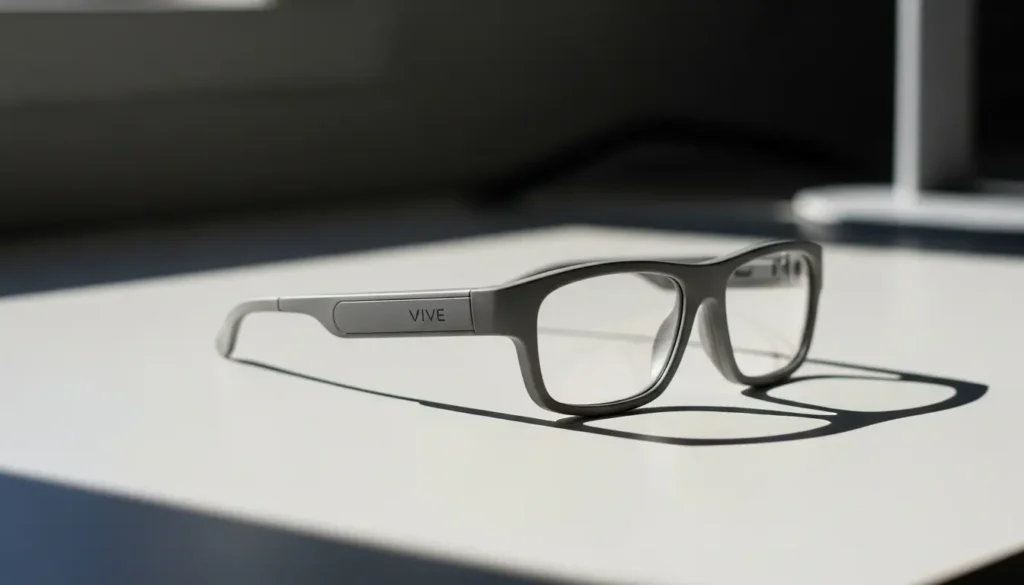
In the fast‑moving world of smart wearables, HTC has stepped into the AI glasses race with its all‑new VIVE Eagle Smart Glasses. The Eagle aims to rival competitors like Meta’s Ray-Ban Smart Glasses by combining sleek design, multiple AI integrations, and strong privacy measures. But is it worth the hype and the price tag? Let’s dive into a complete review.
HTC Vive Eagle Review & Teardown Insights (2025 Update)
The HTC Vive Eagle Smart Glasses have quickly become one of the most searched AI wearables in 2025. With queries like HTC Vive Eagle review, Vive Eagle teardown, and HTC smart glasses features, users are curious to know how HTC’s latest innovation compares to Meta’s Ray-Ban AI Glasses and whether it justifies the $520 price tag.
In this review and update, we’ll cover teardown expectations, performance insights, and key highlights that tech enthusiasts seek.
HTC Vive Eagle Review, Design and Build

The Vive Eagle continues HTC’s tradition of balancing premium build quality with everyday usability. At just 49 grams, these glasses are among the lightest in their category. Compared to Meta’s Ray-Ban AI glasses, the Eagle matches the same comfort level but introduces a sleeker frame with multiple color options, including Berry, Coffee, Grey, Black, and Transparent.
The ZEISS lenses and adjustable nose pads ensure comfort for extended wear, while the IP54 rating gives basic resistance against dust and splashes. This makes them suitable for daily commuting, travel, and outdoor use.
Comfort & Ergonomics
- Adjustable nose pads for a snug fit.
- Ergonomic temples designed for extended use.
- ZEISS sun lenses for eye protection and clarity.
Verdict: The design balances fashion and tech beautifully, making the glasses feel less like a gadget and more like an everyday accessory.
Core Features & Capabilities
1. High‑Quality Camera
The 12MP ultra‑wide camera allows users to take photos and short videos (3024×4032 pixels for images, 1512×2016 @30fps video). Privacy LED indicators ensure transparency while recording. The system automatically turns off recording when the LED is blocked or when glasses are removed.
2. Open‑Ear Audio Experience
Instead of earbuds, HTC uses open-ear speakers to deliver spatial audio with virtual bass. This provides hands-free listening while keeping you aware of your surroundings, which is ideal for city life and travel. Where Meta glasses only support Meta AI, HTC integrates ChatGPT and Google Gemini. This allows multitasking, such as:
- Awareness of surroundings.
- Minimal sound leakage.
- Comfortable, hands‑free listening.
3. AI‑Powered Assistance
This is where the Eagle soars above the competition. Where Meta glasses, which only support Meta AI, HTC integrates ChatGPT and Google Gemini. This allows multitasking, such as:
- Take notes or set reminders.
- Ask general knowledge questions.
- Get restaurant or travel recommendations.
- Real‑time translations into 13 languages (super helpful for travelers).
4. Battery Life & Charging
- Powered by a 235 mAh battery, the Eagle lasts:
- 36 hours on standby.
- 4.5 hours of continuous music playback.
- Fast charging: 50% in just 10 minutes with its magnetic charger.
5. Privacy & Security
Privacy is one of HTC’s most significant selling points. Unlike competitors, your data stays local; nothing is uploaded for AI training. Features include:
- AES‑256 encryption.
- Anonymization of personal interactions.
- No hidden data collection.
For privacy‑conscious users, this is a huge plus compared to Meta’s ecosystem.
HTC Vive Eagle Teardown – Expected Internals

Although an official HTC Vive Eagle teardown has not yet been published by iFixit or repair experts, early insights and hardware leaks suggest the following internal layout:
- Processor & AI chip – likely Qualcomm Snapdragon XR2 or a custom AI-optimized SoC.
- Battery placement – 235mAh compact lithium cell, fitted inside the right arm.
- Camera module – compact 12MP wide-angle lens with stabilization.
- Audio driver – mini open-ear drivers similar to bone-conduction tech.
- PCB layout – split design across both arms (right hosts battery/processor, left manages audio/storage).
This compact design makes the Eagle both lightweight and powerful, though repairability may be limited due to sealed components.
Market Positioning: USA & Canada Outlook
Compared to the Ray‑Ban Meta Smart Glasses, the HTC VIVE Eagle offers more powerful AI features at a higher price tag ($520). However, the Vive Eagle is officially available only in Taiwan via 2020EYEhaus outlets and Taiwan Mobile stores.
Industry experts expect HTC to expand to the USA and Canada by late 2025. At ~$520, the Eagle sits in the premium range compared to the $299 Ray-Ban Meta Smart Glasses, but it justifies the price with stronger privacy, dual AI, and a premium design.
Pros & Cons – Quick Recap
Pros:
- Lightweight (49g) with stylish frames.
- Dual AI assistants (ChatGPT + Gemini).
- Strong privacy-first architecture.
- ZEISS lenses with multiple color options.
- Fast charging (50% in 10 minutes).
Cons:
- Higher price compared to Meta AI glasses.
- Limited global availability (USA/Canada not yet launched).
- No AR visual overlay (only AI + audio features).
- The battery drains quickly with heavy AI use.
Real-World Use Cases
- Travel: Instantly translate signs, menus, and conversations in 13+ languages.
- Productivity: Record voice notes, set reminders, and get quick AI suggestions.
- Content Creation: Capture vlogs or photos hands-free without pulling out your phone.
- Daily Convenience: Listen to podcasts, take calls, and receive navigation prompts while staying aware of surroundings.
Potential Drawbacks
While the VIVE Eagle shows promise, some concerns remain:
- Price barrier: At $520, it’s almost double Meta’s Ray‑Ban AI glasses.
- No global launch date yet, so international users must wait.
- No AR display: Unlike some mixed reality headsets, these are focused on AI + audio, not visual overlays.
FAQs – HTC Vive Eagle Glasses
Q1: Can you use the HTC Vive Eagle with prescription glasses?
Answer: These are standalone glasses, but prescription lens options may be offered separately.
Q2: Is the HTC Vive Eagle safe?
Answer: Yes. Data is stored locally and encrypted, and recording is always transparent with LED indicators.
Q3: Is the HTC Vive Eagle good for gaming?
Answer: No. These smart glasses focus on AI assistance and media, not VR gaming like the original HTC Vive headset.
Q4: Can you use the HTC Vive Eagle without a PC?
Answer: Absolutely. The glasses work independently with the companion VIVE Connect app on smartphones.
Q5. Where can I buy the HTC Vive Eagle Smart Glasses?
Answer: At the moment, the HTC Vive Eagle Smart Glasses are officially available only in Taiwan. You can pre-order them from 2020EYEhaus outlets and selected Taiwan Mobile stores. HTC has not confirmed a global launch yet, but experts believe international availability could follow soon.
Q6. What color options does the VIVE Eagle come in?
Answer: HTC has made sure the VIVE Eagle Smart Glasses don’t just feel futuristic; they look stylish too. Buyers can choose from Berry, Coffee, Grey, Black, and even a transparent variant that stands out as a fashion statement.
Q7. How long does the battery last, and how fast does it charge?
Answer: The VIVE Eagle AI Smart Glasses are built for daily use. They offer:
- 36 hours standby
- 4.5 hours nonstop music playback
- 3+ hours of continuous calls
With the magnetic fast charger, you can get a 0–50% charge in just 10 minutes. Perfect for travel or busy professionals who don’t have time to wait.
Q8. Does the HTC Vive Eagle support real-time translation?
Answer: Yes! One of the smartest features of the HTC Vive Eagle is real-time translation. It currently supports 13+ global languages, including Arabic, Japanese, Korean, Spanish, German, and Thai. This makes it an ideal AI smart glasses for travelers and business users.
Q9: Is there an HTC Vive Eagle teardown available?
Answer: Not yet. However, expected internals suggest a Snapdragon processor, compact battery cell, and split PCB layout for a slim design.
Q10: What is the HTC Vive Eagle price in the USA/Canada?
Answer: The current price is ~$520 in Taiwan. Official US/Canada pricing is expected later in 2025.
Q11: Does HTC Vive Eagle support AR visual display?
Answer: No. It is focused on AI + audio, not augmented reality visuals.
Q12: How does Vive Eagle compare to Ray-Ban Meta glasses?
Answer: Ray-Ban is cheaper and widely available, but HTC Eagle offers better privacy, dual AI assistants, and faster charging.
Conclusion
The HTC Vive Eagle Smart Glasses deliver a unique blend of style, AI power, and privacy-first design. While teardown insights suggest cutting-edge miniaturization, the device still faces challenges with battery life and limited availability. For users who value dual AI integration (ChatGPT + Gemini) and strong privacy protections, the Vive Eagle is a forward-looking choice, even if global adoption may take time.
As global rollout approaches, the search trends around HTC Vive Eagle teardown and review show that this is one of the most anticipated AI wearables for 2025.
If you’re interested in exploring how AI is also transforming everyday digital tools, don’t miss our detailed Comet AI Browser Features Review. It covers powerful AI-driven browsing capabilities that complement innovations like the HTC Vive Eagle Smart Glasses.


